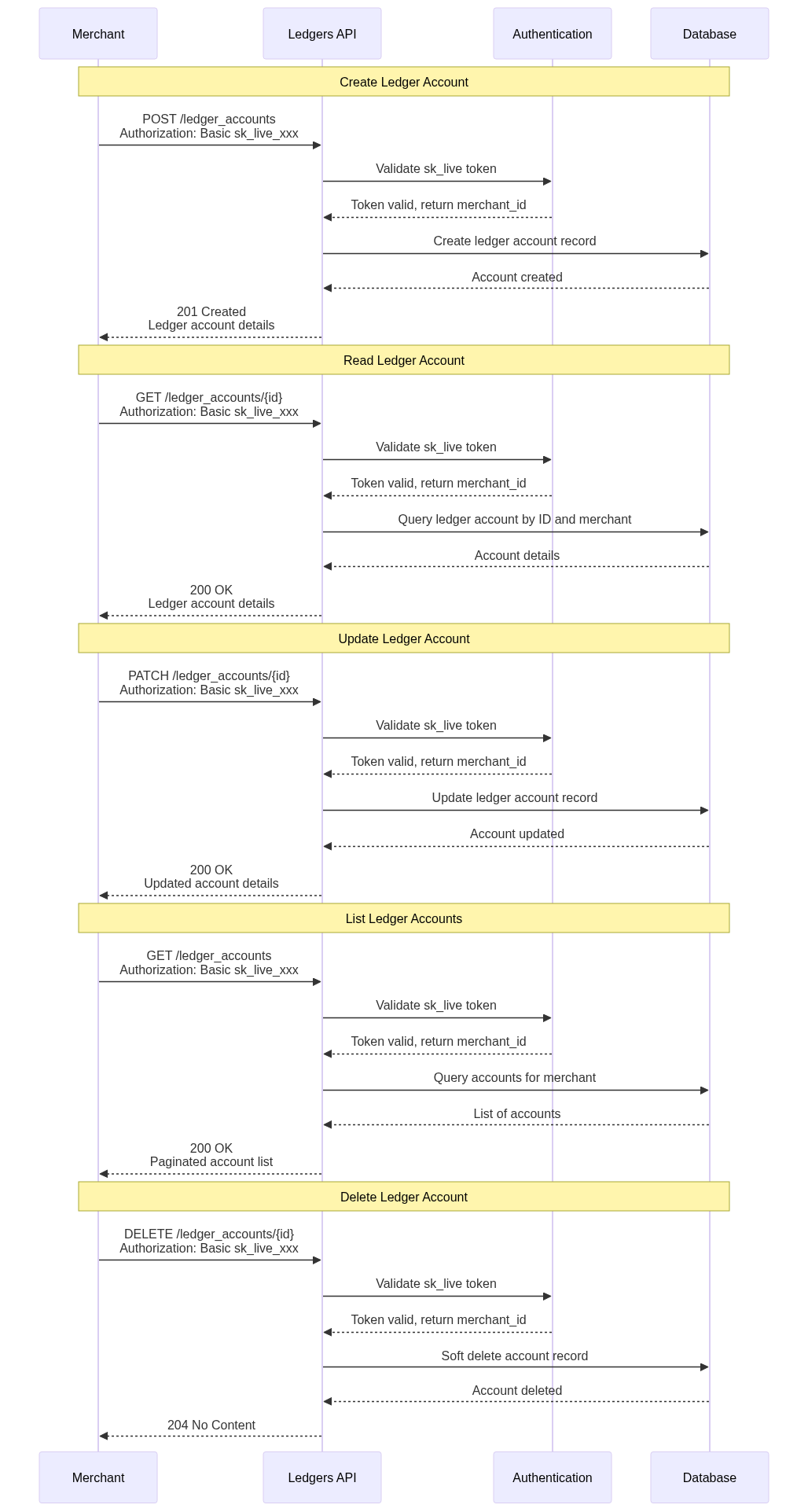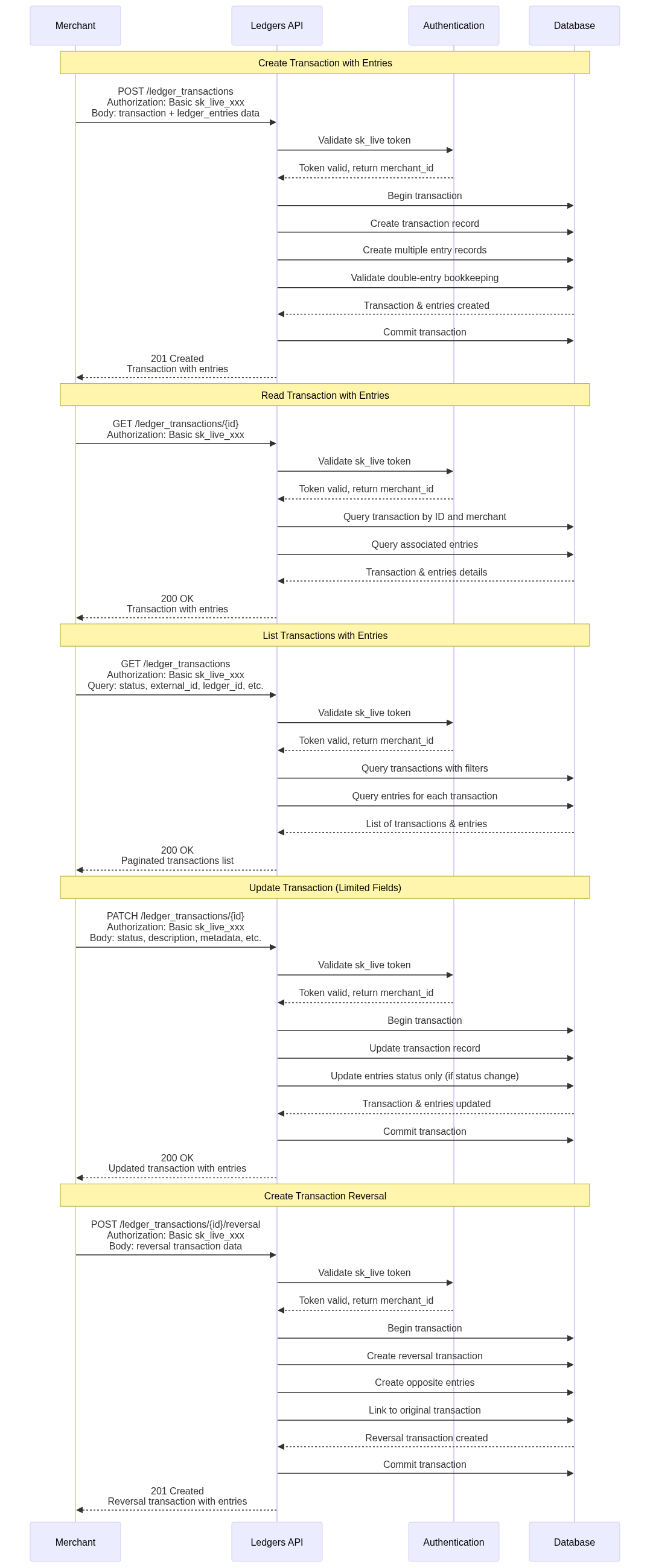Using a Ledger
Overview
This guide provides a concise overview of how to use the Ledgers API, including key concepts like ledgers, ledger accounts, transactions, and entries. It introduces essential terms and the principle of double-entry accounting to help ensure accurate and auditable financial tracking.
To gain access to the Ledgers dashboard, you may request this from [email protected].
Use this guide to support a smooth and reliable integration with the Ledgers system.
Definition of Terms
| Term | Definition |
|---|---|
| Ledger ID | A unique identifier for a specific ledger, which records a complete set of financial transactions. |
| Ledger Account ID | A unique identifier for an individual account within a ledger, used to track specific balances or transactions. |
| Metadata | Additional data or tags attached to a ledger, account, or transaction to provide context or aid in categorization. |
| Balance | The current amount of money or value held in a ledger account at a given time. |
| Ledger | A system of record that tracks all financial transactions, ensuring traceability, consistency, and auditability of balances across accounts. |
| Ledger Accounts | Individual accounts within the ledger assigned to users, merchants, or system entities—each tracking their balance via credits and debits. |
| Transaction | A financial event that changes balances between ledger accounts by generating one or more accounting entries. |
| Entries | The building blocks of a transaction in the ledger, each representing a movement of value (either a debit or a credit). |
| Credit and Debit | Accounting operations applied to ledger accounts—debits reduce balances in asset accounts and credits increase them (and vice versa for liabilities). |
| Double Ledger Entries | The principle that every transaction creates at least two entries: one debit and one credit, keeping the ledger balanced at all times. |
| Reversal | A transaction that negates or offsets a previously posted transaction, effectively undoing its financial impact on the ledger. |
| Available balance | The amount currently accessible for use in the ledger account, factoring in both posted and certain pending transactions. |
| Posted balance | The total value of all finalized (posted) transactions recorded in the ledger account. |
| Pending balance | The sum of transactions that have been initiated but not yet posted to the ledger account. |
Implementation
- To sign in and start using the PayMongo Ledgers, use our guide on Authentication. Start by authenticating with our platform using the Authorization guide to gain secure access to the Ledgers API. This ensures your integration is properly authenticated before interacting with any ledger resources.
- When creating ledger accounts, use our documentation for Create Ledgers.
Refer to the Create Ledgers documentation to set up your organization’s primary ledger. This will serve as the system of record for all associated ledger accounts and transactions.
- _You may create more than one ledger account attributed to your ledger. _Ledgers can support multiple ledger accounts to represent different users, merchants, or internal systems. Each account operates independently and maintains its own set of balances.
- As sandbox is currently not available for Ledgers, you may create a test ledger for test transactions. To simulate ledger behavior, you can create a dedicated test ledger and run controlled transactions. This allows you to safely test your integration without affecting production data.
- To view ledger information – retrieve an individual ledger using this guide. Use the Retrieve Ledger endpoint to access detailed information about a specific ledger. This includes its metadata, configuration, and associated ledger accounts.
- List all created ledger accounts associated with the organization. You can fetch all ledger accounts linked to your organization using the List Ledger Accounts endpoint. This is useful for managing accounts at scale or syncing them with your internal systems.
- Make modifications to the ledger using this guide To make changes to a ledger’s metadata or settings, refer to the Update Ledger endpoint documentation. This ensures your ledger stays up-to-date with any required configuration changes.
- Delete ledger using this guide If a ledger is no longer needed, you can remove it using the Delete Ledger API. Be cautious—this action is irreversible and will affect all associated data.

Ledger Account API flow
- To make ledger transactions, use our set of CRUD APIs. Use the Create, Retrieve, Update, and List Transaction endpoints to manage all ledger transactions. These operations enable you to record, track, and modify financial activity programmatically.

Ledger Information API flow
- Retrieve, list, and update ledger entries. Use this guide to inspect the details of a transaction, retrieve, and update ledger entries. Each entry reflects a debit or credit movement tied to a ledger account.
- To view balances, checkhere. Access real-time balances—including posted, pending, and available—by querying the Ledger Account balance endpoints. This provides a clear view of funds at every stage of processing.

Ledger Transaction & Entries EPI flow
Updated 4 days ago
